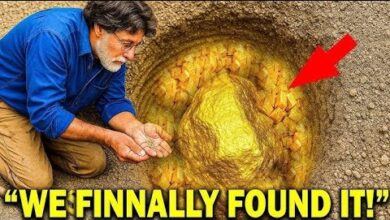The Curse of Oak Island Season 13 Episode 01: What’s Next for the Treasure Hunt?
The Curse of Oak Island Season 13 Episode 01: What’s Next for the Treasure Hunt?

Hey guys, when The Curse of Oak Island premiered its 13th season on November 4th, 2025, it did so under the fitting title The Comeback.
After more than a decade of excavations, disappointments, tantalizing discoveries, and enduring mysteries, the Lagina brothers and their dedicated team have returned with renewed determination.
And perhaps the most compelling evidence yet that the centuries-old Oak Island Enigma might be tied to one of history’s most legendary secret societies, the Knights Templar.
For longtime fans, the first episode of the new season delivers exactly what they’ve come to expect: a blend of real archaeology, historical detective work, and the infectious optimism that has sustained Rick and Marty Lagina’s quest for over 10 years.
Yet, this premiere also manages to rekindle the show’s early magic, offering both emotional resonance and genuinely intriguing new discoveries that hint at a possible breakthrough.
The Comeback opens not with the usual recap of previous discoveries, but with a renewed sense of purpose.
The team gathers on the island’s windswept shores, visibly energized and ready to begin a new chapter.
“There’s a real treasure here,” Rick Lagina declares early in the episode, his words setting the tone for what feels like a spiritual reboot of the entire operation.
The show wastes no time reminding viewers why the Oak Island story continues to fascinate.
For over 230 years, rumors of buried treasure have drawn adventurers, engineers, and dreamers to this small patch of land off the coast of Nova Scotia.
From supposed pirate gold to religious relics and royal treasures, the island has hosted countless theories, but few certainties.
Season 13 appears to be focused on turning theories into evidence.
The strategy this year, Marty explains, is to figure out where that treasure fell into the solution channel.
The term solution channel refers to a subterranean network of flood tunnels that may have been engineered to protect whatever lies in the fabled Money Pit, the heart of the Oak Island mystery.
The team’s goal: to determine exactly where any metallic deposits or even an entire treasure cache might have settled after centuries of geological movement.
This refined strategy is a welcome change from the broader, more speculative excavations of earlier seasons.
It signals a shift toward more focused, science-based exploration driven by data from seismic surveys, borehole analysis, and remote sensing.
The Lagina’s quest has matured into something more disciplined, and the results start to appear sooner than anyone expected.
The Money Pit, the iconic location that started the Oak Island legend in 1795, remains the centerpiece of the show’s investigations.
Over the years, dozens of shafts and boreholes have been drilled around it, revealing a bewildering network of wooden platforms, tunnels, and artifacts.
Yet, despite millions of dollars and countless man-hours, the precise location of the original treasure chamber has remained elusive.
In this episode, the team is particularly excited by new geological data suggesting that the treasure could now be resting in a pocket around 210 ft deep, a level beyond most of their previous explorations.
This revelation sparks both excitement and skepticism. Have they finally located the depth of the original deposit? Or are they chasing yet another phantom, the result of natural sinkholes and water erosion?
Still, when Rick insists the Oak Island story is alive and well, there’s a palpable sense that something significant is unfolding.
The visual evidence—core samples revealing unusual metal content and structures resembling collapsed tunnels—supports their renewed optimism.
Marty, ever the pragmatic engineer, admits that the data is the best lead they’ve had in years.
While the Money Pit continues to draw most of the attention, one of the most intriguing developments in The Comeback occurs on Lot 5, an area on the island’s western side long regarded as less central to the main treasure narrative.
Lot 5 suddenly takes center stage when the team uncovers artifacts that span multiple centuries of human activity.
“There’s a body of evidence on Lot 5 that spans centuries,” one team member observes. “How do you explain that?”
It’s a crucial question. Oak Island has always been layered with history, everything from indigenous settlements to 18th-century ship repair yards.
But the diversity and apparent age of the Lot 5 finds are unusual, even by the island’s standards.
Among the discoveries are remnants of old tools, fragments of ceramics, and what appears to be an early European coin.
When the team examines it more closely, they realize it’s a silver Portuguese coin, possibly dating to the 1500s or early 1600s.
The implications are extraordinary. If confirmed, this would suggest that visitors from Iberia—perhaps explorers, traders, or even Templar-linked seafarers—were present on the island long before British colonization.
“This is something substantial,” Marty remarks, holding the coin with a mixture of disbelief and awe.
For a series that has often been criticized for overhyping minor finds, this discovery feels different.
The Portuguese coin could be tangible proof of transatlantic contact predating official records, connecting Oak Island not only to North American colonial history, but potentially to the Age of Exploration and secret voyages.
The episode’s most electrifying thread, however, revolves around the Knights Templar theory—a recurring motif throughout the show’s run, but one that gains fresh traction here.
According to the episode’s promotional materials, a stunning revelation may help prove the Knights Templar were connected to the 230-year-old mystery.
The evidence, while still circumstantial, aligns intriguingly with the new discoveries.
The Portuguese coin, for example, ties into historical narratives suggesting that Templar survivors, after the order’s dissolution in the 14th century, may have fled to Portugal and later taken part in early maritime exploration.
The possibility that these exiled Templars or their descendants sailed west and concealed sacred relics or treasures in the New World has long fascinated historians and theorists alike.
Rick Lagina, ever the romantic historian, reflects on this idea with characteristic humility:
“We know that people were involved doing something, but why and who?”
It’s precisely this blend of hard evidence and open-ended wonder that keeps The Curse of Oak Island compelling after so many seasons.
By connecting the dots between medieval Europe and 18th-century Nova Scotia, The Comeback breathes new life into the Templar hypothesis—not as mere legend, but as a plausible chapter in a larger unfinished story.
What sets season 13 apart so far is the balance between scientific rigor and emotional conviction.
The Lagina brothers have always embodied these dual impulses: Marty the empiricist, Rick the believer.
Their differing temperaments have often defined the show’s rhythm—methodical testing punctuated by moments of heartfelt reflection.
In The Comeback, these roles are as pronounced as ever. Marty oversees the technological operations, data modeling, deep core drilling, and sonar imaging, while Rick focuses on the human and historical dimensions, often reminding the team that the truth of Oak Island isn’t just in what we find, but in what we understand.
This synergy creates one of the episode’s most memorable moments when, after hours of analysis and excavation, the team finally extracts a piece of material that appears metallic.
The camera lingers on their faces: hopeful, cautious, almost reverent as the object is cleaned and examined.
“There’s treasure on that island,” one voice says softly. “Here’s the proof.”
Whether that statement holds up under further scrutiny remains to be seen, but the emotional impact is undeniable.
Beyond the mystery and science, The Curse of Oak Island endures because of its human story: the camaraderie, perseverance, and generational passion that defined the Lagina family’s journey.
“You know how close you are to the one thing that will tell you the whole story,” Rick says near the episode’s end.
It’s a line that resonates not only as a promise to the audience, but as a reflection of the brothers’ own lifelong pursuit of truth.
Thirteen seasons in, the Oak Island team spirit remains unbroken.
“We’re not going home,” Rick declares in the closing moments. And it’s clear he means it.
After decades of speculation and near misses, this is not just another season.
It’s a reaffirmation of belief, a declaration that the mystery is still alive and the treasure, whatever form it takes, is still within reach.
The Comeback succeeds in what any long-running series must eventually do: it reinvigorates its premise without abandoning its roots by emphasizing renewed purpose, scientific precision, and historical depth.
The episode avoids feeling repetitive while still honoring the mythic allure that first drew viewers to the island.
If the rest of season 13 follows the trajectory set by this premiere, fans can expect one of the most consequential chapters in The Curse of Oak Island’s history.
The combination of a refined search strategy, the intriguing Lot 5 findings, and the reemerging Templar connection could lead to genuine breakthroughs—or at the very least, the kind of revelations that keep the legend alive for another generation.
As the episode closes with sweeping drone shots of the island bathed in the golden light of sunset, the narration reminds us of why this story endures:
“There’s still something here, something that has waited centuries to be found.”
Indeed, The Curse of Oak Island has always been about more than treasure.
It’s about perseverance in the face of mystery, the pursuit of knowledge, and the unyielding belief that some secrets are worth the dig.
With The Comeback, the Laginas and their team have done more than relaunch their search—they’ve reignited the world’s fascination with Oak Island itself.
As the credits rolled on The Comeback, one thing became clear: The Curse of Oak Island is no longer just a television show about digging holes.
It has evolved into a living chronicle of discovery, endurance, and faith in the unknown.
Each new season adds another layer to the legend, and season 13 appears poised to deepen both the mystery and the meaning behind it.
What keeps audiences returning year after year is not simply the promise of gold or artifacts, but the profound sense of connection to history, to mystery, and to the spirit of exploration that defines humanity itself.
Oak Island, once a quiet patch of land in Nova Scotia, has become a metaphor for the search for truth in a world that still holds secrets.
Another notable element in the premiere is the team’s expanding use of advanced technology, which bridges the gap between 18th-century legend and 21st-century science.
Ground-penetrating radar, 3D subsurface modeling, and chemical soil analysis now complement traditional excavation methods, giving the Laginas a clearer understanding of where to dig and what to expect.
The introduction of these tools not only increases the likelihood of success, but also symbolizes how modern innovation can shed light on ancient mysteries.
It’s a striking contrast: centuries-old coins and artifacts being unearthed with state-of-the-art precision.
In many ways, this marriage of the old and the new encapsulates the essence of the Oak Island project itself—a continuous dialogue between history and progress.
Equally compelling in this episode is the emotional maturity of the team’s interactions.
After more than a decade of shared triumphs and setbacks, the camaraderie among the crew feels stronger than ever.
Whether it’s Gary Drayton’s unflagging enthusiasm as he swings his metal detector across Lot 5, or Charles Barkhouse’s quiet confidence rooted in his deep historical knowledge, every member contributes something vital to the dynamic.
Their unity is a reminder that the quest has always been as much about people as it is about treasure.
The moments of laughter, tension, and reflection captured between the digs and discoveries lend the show a genuine warmth that balances its technical and historical intensity.
Thematically, The Comeback also underscores the idea of persistence in the face of uncertainty.
Oak Island has broken the spirits of many who came before the Laginas—engineers, treasure hunters, even historical societies that ran out of funds or patience.
Yet, the current team’s refusal to quit has turned the endeavor into something bigger than any single discovery.
Each fragment of wood, each metallic trace, and each ancient coin serves as a reminder that history rarely gives up its secrets easily.
The Laginas’ commitment after more than a decade of searching reflects a deeper truth: the journey itself is the reward.
Their unshakable belief that they are on the verge of understanding the island’s full story transforms their persistence into something almost heroic.
Finally, the premiere leaves audiences with a renewed sense of anticipation.
With new leads on both the Money Pit and Lot 5, and the tantalizing reemergence of the Knights Templar theory, The Curse of Oak Island season 13 feels primed to deliver on long-standing promises.
Whether or not the treasure itself is ever found may ultimately prove secondary to the knowledge and inspiration drawn from the search.
For the Lagina brothers and their devoted followers, Oak Island represents the enduring human desire to uncover the past, to prove that legends are rooted in truth, and that even the most elusive mysteries can one day be solved.
As Rick’s voice echoes over the closing scene, “We’re not going home.”
It’s clear that the adventure is far from over.
In fact, for Oak Island, The Comeback may just be the beginning of its most revealing chapter yet.








